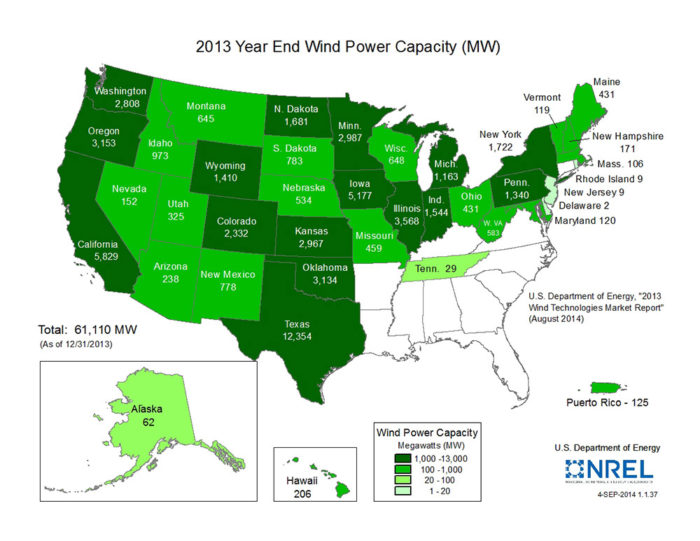
Image Credit: National Renewable Energy Laboratory
Connecticut could have its first utility-scale wind project by the middle of next year after the state Supreme Court dismissed the appeal of a citizens’ group to end a four-year regulatory and legal battle.
The court’s decision in mid-September lowered one of the last barriers preventing BNE Energy Inc. from developing two sites in the northwest part of the state. BNE plans to install a total of six 1.6-megawatt turbines, three at each of two sites in the town of Colebrook.
The Hartford Courant reports BNE has already built some access roads to one of the sites and has done some preliminary work on the turbines. But the company was waiting for the court’s decision before putting any more money at risk.
It’s been a long and bumpy road for BNE, which originally filed applications with the Connecticut Siting Council, the state agency that rules on power plants and transmission lines, in late 2010.
Shortly after the applications were filed, explained Melanie Bachman, the acting executive director and staff attorney for the council, the state Legislature imposed a moratorium on commercial wind projects. The ban was lifted only when the council drafted wind-specific regulations and a legislative committee approved them.
The moratorium didn’t affect the BNE projects directly. “Because those projects were submitted before the bills had passed, they were exempt,” she told GBA. “So [the BNE] projects could move forward. But if anyone else came in with a proposal for a wind project there would be a moratorium until the regulations were adopted.”
BNE sought approval for three projects — the two in Colebrook plus a third in the town of Prospect, southeast of Waterbury. The Siting Council gave the OK to the Colebrook turbines in 2011 but denied the petition for the Prospect project. Then a group called FairWindCT took the issue into the courts.
“They’re ready to go,” Bachman said this week. “There are no more obstacles, but it’s 2014. It took four years for them to get through the process… It was such a laborious and contentious ordeal.”
FairWind objected to setback requirements
Bachman said Connecticut is a little unusual in that a committee of the state legislature reviews and approves regulations of administrative agencies like the Siting Council. It’s somewhat controversial, she said, because legislators are not experts in the technical areas they regulate.
In the case of rules governing utility-scale wind projects, it took the Siting Council five tries to get the proposals approved by the legislative committee. They were accepted on Earth Day 2014.
“Each time we thought we cleared a hurdle and drafted regulations that responded to their concerns they’d have another concern about another provision, so we’d have to go back and work on that,” Bachman said. “Eventually, they finally passed.”
She called the process a “debacle.”
A key stumbling point was a setback requirement that turbines be at least 1.5 times their height away from property lines (height in this case means the distance from the ground to the tip of the blade at the highest point of its arc). Bachman said the practical effect of the setback was a minimum lot size of 45 acres for a 500-foot tall turbine, not so easy to find in a small and relatively populated state like Connecticut.
FairWind, however, thought the setbacks should have been much greater. “A setback distance of 1.5 [times] the turbine height is not enough!” says a blog posted at the group’s website.
At the Colebrook projects, one turbine will be located 435 feet from a sportsman’s club property; another will be 235 feet from a nature conservancy property line. Neither would meet the setback requirement, but because BNE was exempted, the projects can be built as planned.
Weekly Newsletter
Get building science and energy efficiency advice, plus special offers, in your inbox.















0 Comments
Log in or create an account to post a comment.
Sign up Log in